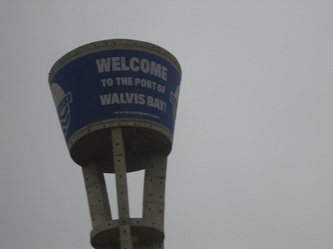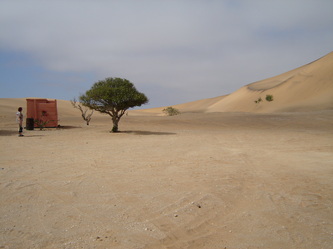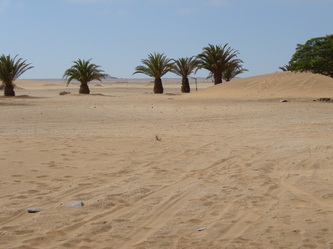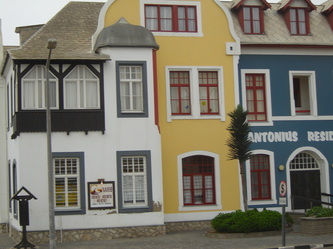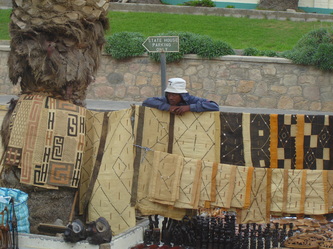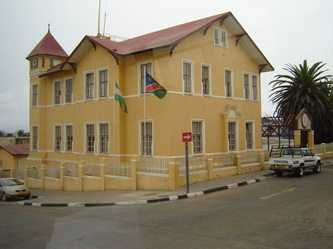Namibia.
The earth is not ours, it is a treasure we hold in trust for future generations. -- Nambia Proverb
(http://www.historyofpainters.com/nambia_proverbs.htm)
Walvis Bay - Namib Desert - Swakopfmund.
Walvis Bay, or "Whale Bay" (Afrikaans: Walvisbaai,) located on the Atlantic Ocean, is a port city in Namibia.
In 1878 Britain annexed the Bay and in 1884 this territory was incorporated into Britain’s Cape Colony (today a part of South Africa.). The same year Germany established the colony of South West Africa.
In 1910, in accordance with the Act of Union, Walvis Bay became a part of South Africa.
and was under South African management from 1978 until 1990. In 1994 territorial control was officially transferred to Namibia.
Walvis Bay is located on the edge of Namib Desert. The city is located by dike and half of Walvis Bay is situated below sea level (around two meters below).
The harbor if Walvis Bay was an important strategical place for the South African Navy. The port served as an exported point of uranium.
Since 1970 overfishing caused the increase of importance of harbor.
Visitor's diary:
"From Walvis Bay we drove along the coast, first visiting the sand dunes that had created a desert directly across from the sea. We continued along the coast to an old mine, where we visited the mine and its museum.
Finally, we reached our distination of Swakopfmund."
Swakopmund
Founded in 1892, it served as the main port for German South-West Africa and
remains a perfect example of German colonial architecture. A large part of the 42,000
inhabitants are German-speaking today.
The town is 193 square kilometres (75 sq mi) in size and is a popular beach resort.
Swakopmund is the capital of the Erongo Region. Nowadays it is a top travel destination of Namibia that attracts travelers by a huge amount of activities.
Tourists are impressed by the coastal road that is surrounded by dunes from one side and by the Atlantic Ocean from another. Here you can find a lot of sights: gorgeous buildings, National Marine Aquarium, promenades, and amazing nature.
Swakopmund has mild climatic conditions. The highest season for tourism here in December and January; that’s why it is better to pre-book tickets.
(Google Search, Google, www.google.com/search?ei=ElRQXNvuOsmckwXAyqXoCA&q=namibia%2C%2Bschwakopfmund&oq=namibia%2C%2Bschwakopfmund&gs_l=psy-ab.3..0i13l6j0i13i30l4.825333.838322..839767...0.0..0.593.5079.0j10j9j2j0j1......0....1..gws-wiz.......0j0i67j0i19j0i22i30i19j0i22i30j0i22i10i30j33i160.xgDme9up5t4.)
Visitor's diary:
"Our guide spoke perfect “Hannover” German that was better that many of the German guests. When he was asked when the last time he was in Germany, he answered that he had never been out of his home town, Swakopmund. He grew up speaking German at home and in school."
“During World War I, German South-West Africa (now called Namibia) was invaded and administered by South African and British forces. Following the war, its administration was taken over by the Union of South Africa, and the territory was governed under a trusteeship granted in 1920 by the League of Nations. A request made by the Union of South Africa that they be able to incorporate the territory of South-West Africa into their sovereign boundaries was countered by the President-General of The African National Congress (ANC), Dr. AB Xuma, who on January 22, 1946, cabled the United Nations with his concerns regarding the absorption of South-West Africa into the Union of South Africa. As a result, the United Nations requested that the Union of South Africa place the territory of South-West Africa under a UN trusteeship, allowing international monitoring. The Union of South Africa rejected this request.
On August 26, 1966, having become the Republic of South Africa, it continued its jurisdiction over South-West Africa and refused to leave. As a result, a conflict began with the first clash occurring between the Republic of South Africa’s Police Force and the People’s Liberation Army of Namibia. This started what came to be known as the Border War. In 1971 the International Court of Justice, the primary judicial branch of the United Nations, based at the Peace Palace in the Hague, Netherlands, ruled that the Republic of South Africa’s jurisdiction over the Namibian Territory was illegal and that they should withdraw.”
― Captain Hank Bracker, "The Exciting Story of Cuba"
www.goodreads.com/quotes/tag/namibia
Namibia; Swakopmund Tourist Guide
Get information here to plan your holidays in Swakopmund within a reasonable budget .
Visit the official site of Namibia; Swakopmund:
Namibian Tourism
By Air:
Airport: Swakopmund Airport
Air lines
- Air Namibia: Flights operate from Windhoek as well as Cape Town in South Africa; Walvis Bay.
- South African Airways: They operate flights from Johannesburg and Cape Town. SAA flights also operate from Walvis Bay.
- By small aircraft
By ship:
The best way to get Namibia by ship is to use the cruise ferry.
For independent trips use main Namibia’s Port is Walvis Bay and Lüderitz; get Namibia by ship by using pontoon ferry crossing from Wenela Zambian Side.
By Car:
The best way to get to Swakopmund is 4 to 5 hours drive away from Windhoek by road. The B2 is the main road from Windhoek.
http://namibia.rentalcargroup.com/swakopmund_downtown.htm
By Bus:
By minibus: Mini Buses are slightly cheaper and are an experience, they have no fixed time schedule. Minibuses operate from Windhoek almost every 2-3 hours. The ride will take about 4-6 hours.
Private Bus
· Intercape
· Econolux: Tel +264 64 205935.
· Town Hoppers Shuttle Service: air conditioned bus: Tel +264 64 407223 or
[email protected]
By train:
Traveling Namibia by train is an excellent opportunity to explore the country.
The train service to Windhoek will take up to 21 and a half hour. The main railway of Namibia is called TransNamib railways.
Trips by train start at the capital of Namibia Windhoek. From this point, you can get any direction in the east, west, north, and south part of the country.
The most luxurious way to travel across Namibia is to choose Desert Express. The two-way ticket will cost you around four thousand Namibian dollars (appx. four hundred US dollars).
This type of traveling suggests you comfortable compartment with air-conditioning for one till three people. Usually, there is access to the lounge, bars, and delicious Namibian meals.
The second way to travel Namibia by train is to choose Starline. The trip costs one hundred Namibian dollars (around 7 US dollars) but it can be changed due to the way of your destination. The tickets should be pre-booked. If you are traveling more than twelve trips - you get the discount.
The main railway directions in Namibia are:
- Windhoek - Gobabis - Windhoek (it includes the cities: Hoffnung, Neudamm, Omitara, Witvlei, Gobabis)
- Windhoek - Otjiwarongo - Windhoek (it includes the cities: Okahandja, Karibib, Kranzberg, Omaruru, Otjiwarongo)
- Windhoek - Walvis Bay - Windhoek (it includes such cities: Usakos, Arandis, Kuiseb, Karibib)
- Karasburg - Keetmanshoop - Windhoek (it includes the cities: Tses, Asab, Gibeon,Mariental, Kalkrad, Rehoboth)
- Karasburg
- Keetmanshoop
- Luderitz
- Mariental
- Windhoek
- Gobabis
- Walvis Bay
- Swakopmund
- Okahandja
- Omaruru
- Otjiwarongo
- Tsumeb
Accommodation
Visit Tripadvisor for budget rate accommodations.
